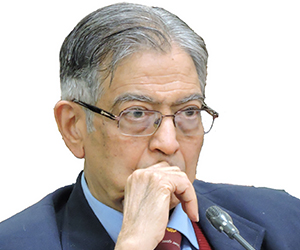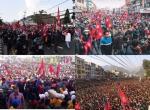With the dust of the 2024 election having finally settled and a new National Democratic Alliance (NDA) government having been sworn in it is now appropriate to attempt to tease out some of its key takeaways.
For starters, it should definitively put to rest the thesis propagated ad nauseum by elements in the West as well as by the Opposition that Democracy in India is in danger, that a dictatorial Modi will manipulate it, that the Election Commission has been so undermined that it is incapable of holding a free and fair election, and that electronic voting machines cannot be trusted. The election outcome, contrary to all expectations, with the Congress almost doubling its seat share to 99 and the BJP with 240 seats falling well short of a majority and garnering one only with allies reflects the fact that Western critics and the Opposition at best got it all wrong and at worst were engaged in deliberately spreading a false narrative far removed from reality for their own nefarious ends. If they made a genuine error, one would expect a mea culpa from them but if they persist in their projections of the Indian Democracy being in danger then it would prove that they are the purveyors of a false narrative geared to undermine India. The clear readout from the elections is that Indian Democracy is flourishing and not being undermined by an authoritarian Modi, that the Election Commission and supporting machinery, as in the past, did India proud in ensuring free and fair elections in trying weather conditions in the world’s most populous Democracy, and that the electronic voting machines proved an invaluable technological tool in the electoral process.
Secondly, the contention that the Indian electorate wants a Modi government but one that is reined in by coalition partners is poppycock and simply an attempt to rationalise the outcome. The hard reality is that there were only two types of voters: those that wanted a Modi government with a strong majority and those that did not want it. What ultimately transpired is that we have a Modi government but one that is somewhat dependent on its allies. This did not happen by design on the part of the voters but was an accident in the numbers game natural to all elections.
Thirdly, it is completely wrong to argue, as done by the Opposition, that the BJP has lost its mandate and that brand Modi has been severely dented. Since the BJP along with its prepoll allies in the NDA has a comfortable majority of 292 seats in a House of 543 it has obviously not lost its mandate and only an Opposition devoid of reason or plain blinded by hatred could suggest this. Similarly, though the BJP has not done as well as expected it is puerile to contend that brand Modi has been badly tarnished. The fact is that he has become only the second Indian Prime Minister after Nehru to be elected for a third consecutive five year term, that he is by far the tallest leader in India with a proven track record of innumerable achievements, that in the recently held elections he led the BJP to comprehensive victories in many states like Gujarat, Orissa, MP, Delhi etc, and that his party’s seat share in the impending coalition government will dwarf the seat shares of the single largest parties in earlier coalition governments. In fact, the BJP’s seat share today is even larger than that of the entire I.N.D.I.A. alliance.
Fourth, the speculation about the longevity of the impending NDA government. fuelled by an Opposition hell bent on seeing the end of Modi, is unfounded as earlier coalition governments whether under Vajpayee or Manmohan Singh with much smaller lead parties lasted their full term. Clearly, on this count alone the longevity of the upcoming NDA government should not be in doubt and one may confidently expect it to last its full term. Added to this is the fact that both the Telugu Desam Party (TDP) with 16 seats and the Janata Dal United (JDU) with 12 seats have been a part of the NDA earlier and there is much in common in their agendas. While these parties have in the past defected away from the NDA there is no incentive for them to do so today as they have much to gain from staying within it and an uncertain future in moving to a fractious Opposition whose prospects of coming to office are bleak. Moreover, neither the TDP nor the JDU is, on its own, critical to the survival of the BJP led NDA coalition which will, as time goes on, only increase in strength particularly by accretion of independent MP’s and other smaller parties.
Fifth, the nature of the impending coalition government is such that one can safely assume that there will be a considerable continuity in the thrust of the policies pursued in the last ten years. This is particularly so in the case of Foreign Policy, Defence, and the Development Agenda. Both the TDP and JDU are in more or less complete sync in these areas with the BJP and they will readily play ball on most issues as the economic requirements for their respective States which are critical to them will almost certainly be addressed by the BJP. It is only in respect of a handful of issues like the cast census where there could be differences but mutual adjustments should not prove to be overly difficult to sort them out.
Sixth, the difference in the ethos and character of the Congress and the BJP was starkly reflected in their reactions to the election outcome. While, on the one hand, the Congress, though condemned to remain in the Opposition, was all smiles, on the other hand, the BJP was subdued even though it had garnered the mandate to govern for a third consecutive term with a substantial seat share and with many spectacular electoral victories.
Finally, it is evident that the election outcome entailing a loss of over 60 seats for the BJP constitutes a serious set back for it. It will no doubt introspect into the reasons for the losses it suffered, take remedial action, and come out stronger. Listed below are some of the factors which, perhaps, played a part in the BJP’s below than expected performance:
- Lower turn out of BJP voters due to over confidence bred by projections of a 400 plus seat share which should have been avoided, lack of enthusiasm of RSS ‘karya kartas’ in getting voters to the booths, and heat wave conditions;
- In UP there was a consolidation of the Muslim and lower caste vote against the BJP coupled with poor seat selection by the latter. Moreover, factors which should have played in favour of the BJP like the Ram Mandir did not because of mismanagement in the disposal of land around it to the detriment of the owners, and disruption in the lives of the locals due to VIP movement.
- Insufficient attention to countering the Opposition’s false narrative which gained much traction on issues like the BJP intending to amend the Constitution, its hostility to reservations, the negative impact of the Agniveer programme, Modi’s authoritarianism etc
- In the States where the party did poorly there was a complacency in the local leadership which was also less than effective in spreading the word about the party’s considerable achievements and in countering the false narrative spread by the Opposition.
It may, in conclusion, be mentioned that what we are likely to see in the coming days is more of the same: notably a continuation of the main thrust of the Modi government’s earlier policies in most domains and an obstructionist Opposition determined to oppose the government for the sake of opposing it. The Opposition’s visceral antipathy towards the new government was evident by the absence of all its leaders, barring Kharge, from the swearing in ceremony and its view that the Modi government has lost the moral right to govern. In these circumstances, managing Parliament will be far more difficult than in the past particularly because of the BJP’s reduced numbers, it having to rely on allies for a majority, and the substantial I.N.D.I.A alliance presence.
(The paper is the author’s individual scholastic articulation. The author certifies that the article/paper is original in content, unpublished and it has not been submitted for publication/web upload elsewhere, and that the facts and figures quoted are duly referenced, as needed, and are believed to be correct). (The paper does not necessarily represent the organisational stance... More >>
Image Source: https://www.pmindia.gov.in/wp-content/uploads/2024/06/H20240609160343.jpg










Post new comment